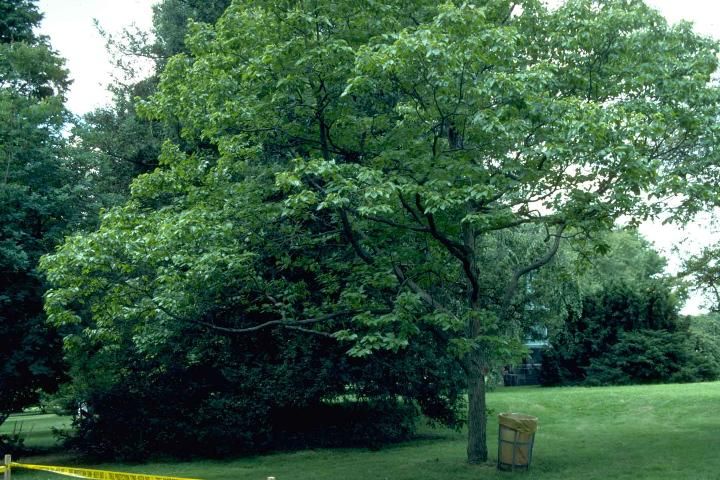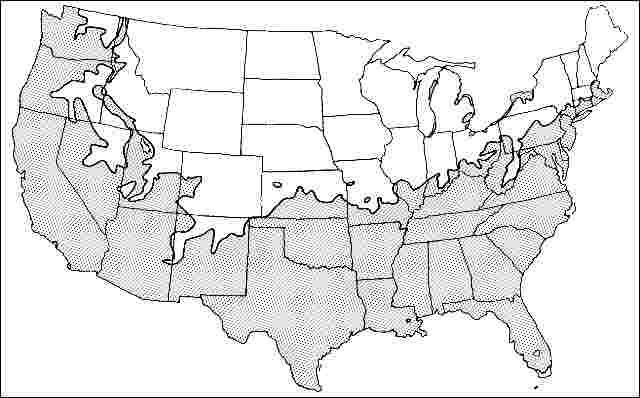Introduction
Japanese Raisintree can reach 40 to 50 feet in height but is most often seen at 30 to 35 feet with an open, upright, oval silhouette. Unfortunately it is a little too big for planting beneath most power lines. The tree usually maintains a fairly good central leader with small-diameter main branches. The four to six-inch-long, glossy green leaves are particularly striking and create light shade below the trees but they show no appreciable color change in autumn, dropping while they are still green. In early summer, the branch-tips of the trees are festooned with small, two to three-inch-long cymes of sweetly-fragrant, greenish-white flowers which are quite attractive to insects. These blooms are followed by the production of small, fleshy, brown drupes which ripen to bright red and have a flavor similar to a sweet raisin, giving the tree its common name.

Credit: Ed Gilman
General Information
Scientific name: Hovenia dulcis
Pronunciation: hoe-VEE-nee-ah DULL-sis
Common name(s): Japanese Raisintree
Family: Rhamnaceae
USDA hardiness zones: 6A through 10A (Fig. 2)
Origin: not native to North America
Invasive potential: little invasive potential
Uses: parking lot island 100-200 sq ft; parking lot island > 200 sq ft; highway median; tree lawn 4-6 feet wide; tree lawn > 6 ft wide; specimen; container or planter; street without sidewalk; shade
Availability: not native to North America

Description
Height: 30 to 35 feet
Spread: 15 to 25 feet
Crown uniformity: symmetrical
Crown shape: upright/erect, oval, pyramidal
Crown density: open
Growth rate: moderate
Texture: medium
Foliage
Leaf arrangement: alternate (Fig. 3)
Leaf type: simple
Leaf margin: serrate
Leaf shape: ovate, elliptic (oval)
Leaf venation: pinnate, reticulate
Leaf type and persistence: deciduous
Leaf blade length: 4 to 8 inches
Leaf color: green
Fall color: no color change
Fall characteristic: not showy

Flower
Flower color: white/cream/gray
Flower characteristics: showy
Fruit
Fruit shape: round
Fruit length: less than .5 inch
Fruit covering: fleshy
Fruit color: red
Fruit characteristics: attracts birds; showy; fruit/leaves a litter problem
Trunk and Branches
Trunk/bark/branches: branches don't droop; showy; typically one trunk; thorns
Pruning requirement: little required
Breakage: resistant
Current year twig color: brown
Current year twig thickness: thin, medium
Wood specific gravity: unknown
Culture
Light requirement: full sun, partial sun or partial shade
Soil tolerances: clay; sand; loam; alkaline; acidic; occasionally wet; well-drained
Drought tolerance: moderate
Aerosol salt tolerance: unknown
Other
Roots: not a problem
Winter interest: yes
Outstanding tree: yes
Ozone sensitivity: unknown
Verticillium wilt susceptibility: unknown
Pest resistance: free of serious pests and diseases
Use and Management
The bark of Japanese Raisintree is ridged and an attractive light grey with brown valleys. Lower branches can be removed or trimmed to display the lovely bark. The trunk often grows straight up the center of the tree without training.
The moderate growth rate, upright habit, and striking flowers and fruit make Japanese Raisintree useful as a specimen or container tree. It is a candidate for trying as a street tree due to its small to medium size and ascending branches, but has not yet been extensively used for this purpose.
Trees will grow in almost any well-drained soil in full sun or partial shade. Not for poorly-drained areas or compacted soil, Japanese Raisintree prefers adequate soil space for root exploration.
Propagation is by seed or cuttings.
Pests and Diseases
No pests or diseases are of major concern.